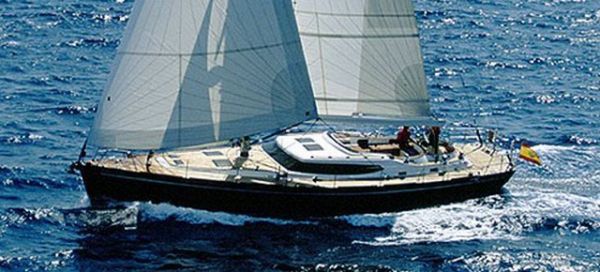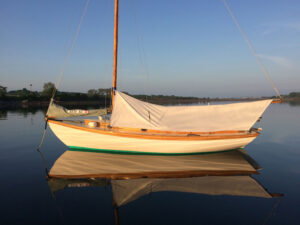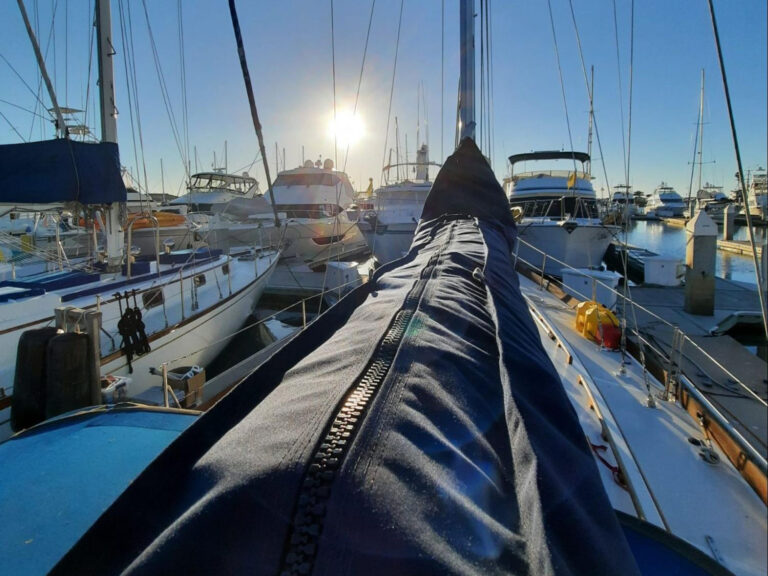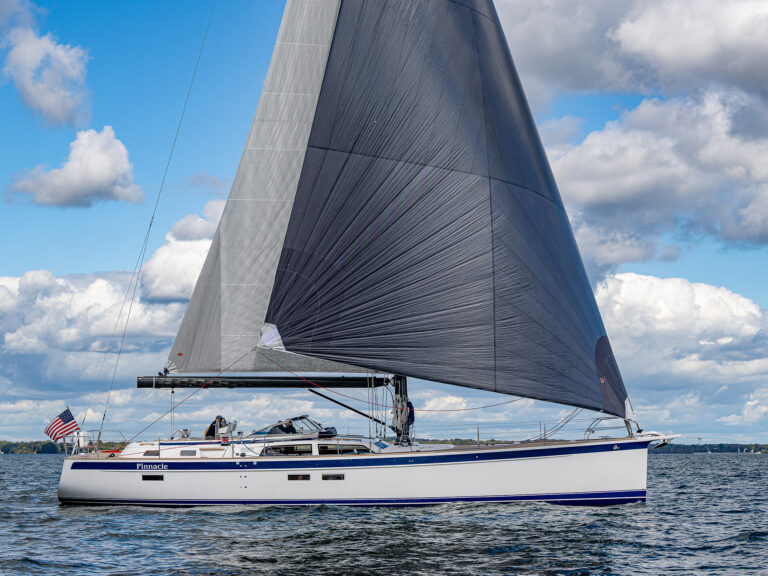
For 75 years now, Sparkman & Stephens has been celebrated for its body of design work that underpins hundreds of capable, long-lived, oceangoing sailboats. North Wind Yachts is a high-quality boatbuilder based in the commercial port of Barcelona, Spain. Together, the designer and builder of the North Wind 58 have created a passagemaker that blends oceangoing scantlings with the grace and elegance of a fine yacht.
During a dockside inspection of the North Wind 58, I was particularly impressed by the custom-fabricated metalwork that ranges from a rugged stem fitting and anchor roller to the functional and handsome stainless-steel galley counters. I would add further high marks for the excellent mechanical installation of the Mercedes diesel (though a Yanmar is standard) and drivetrain, which features an Aqua Drive shaft coupling; when running, it’s as smooth as butter. I quickly came to see that this yard employs a staff with a wide range of talents. The installations of the hydraulic anchor windlass, bow thruster, and furling systems are additional examples of competent craftsmen at work.
Before we got under way, I wondered if the 58, her sleek-looking deck-saloon lines notwithstanding, might behave like a slow motorsailer. Any doubt was dispelled the moment we set sail. Her big rig, substantial sail plan, and new keel, mast, and rudder turn this high-volume cruiser into a passagemaker that’s not afraid to perform. The 7-foot-8-inch draft and the rig height will keep the boat out of the Intracoastal Waterway, but this is a sailboat designed and built to go to sea–a job at which it excels.
On the wind, with a reefed main and a double head rig, the boat loped along at 8.7 knots, and the motion induced by the short, steep chop of Chesapeake Bay was comfortable. Unlike a raceboat, in which speed trumps all other attributes, seakindliness is essential in a cruiser, and that derives to a large degree from the motion of the vessel in a seaway. The North Wind’s moderate proportions and balanced ends eliminate pounding and allow those on deck and below to function effectively, even when the boat’s beating to weather. The deep spade rudder afforded smooth steering and positive control even when the heel angle increased during 10-knot jumps in the apparent wind. The heavily built, well-supported rudderstock reassured me that although S&S, one of the last holdouts advocating skeg-hung rudders, has embraced freestanding rudders on cruising boats, they’ve done so with the hefty belt-and-suspenders scantlings for which they’re famous.
The boat’s reaching ability is another strong suit. Its directional stability is good, and whether hand steering or turning the helm over to the autopilot, the easy-to-balance sail plan and positive steering characteristics make this 58 a very easy boat to control. Gusts would come and go without unduly affecting heel or overwhelming the steering. The double head rig allows a shorthanded crew to furl the genoa and move the center of effort (CE) aft at the same time that the reefing of the mainsail is moving the CE forward. The result is a balanced sail plan; even at hull speed, the steering remains easy. These same characteristics would play out well in open-ocean sailing when the boat accelerates off steep wave faces.
The 58 is available in a sloop or ketch rig, and either can be fitted with carbon spars as an option. In-mast furling is standard, and although there’s a trade-off in efficiency under sail, it affords a decided convenience. A bow thruster and electric sheet winches are also part of the package, another effort to make a large vessel more friendly to a shorthanded crew. Each of these labor-saving systems has a manual backup in the event that the power goes out; effective ongoing maintenance will lessen the likelihood of having to do without the furling, reefing, and sheeting aids.
Construction
The North Wind 58 hull and deck are fashioned using a well-executed fiber-reinforced-plastic (FRP) sandwich-construction technique whereby the foam core is vacuum-bagged into place. Throughout the bilge and in the lockers forward and aft, the visible glasswork and bulkhead tabbing is neat, and it indicates a high fiber-to-resin ratio. The molding process seems to follow the same effective quality control apparent elsewhere.
Part of the engineering challenge in building sailboats with raised deck saloons is the reinforcement of a superstructure that by its very nature has large unsupported spans and numerous holes cut for windows, hatches, and ports. Careful analysis of the sailing loads as well as the point loads associated with large breaking seas cause engineers to add significant reinforcement to the deck in and around the major apertures. Window material and bedding systems also are key factors in the success of these projects, and they’re part of the reason why a design firm such as S&S, with its experienced engineering staff, brings such value to a vessel like this. Many bluewater veterans see provisions for storm shutters as a must for long offshore passages aboard deck-saloon vessels with large windows, and another advantage of a semicustom builder is its ability to accommodate such requests.
The fit of glue joints and finish work on surfaces both flat and curved was good. I always like to see careful attention even to details hidden in hard-to-access places where a prospective buyer seldom looks, and the North Wind didn’t let me down. The styling in the main saloon is more oriented to in-port entertainment than some voyaging sailors might prefer, but part of the mission of a deck-saloon sailboat is to soften the edges of hardcore passagemaking.
Systems
Producing the electrical energy for a cruiser that contains all the comforts of home is an engineering feat that builders often gloss over, and its significance isn’t fully understood until the power cord is pulled and the batteries go dead in the first few days of underway autonomy. The North Wind has an electrical plant capable of sustaining air-conditioning, cabin heating, watermaking, and all the electronic loads associated with the sophisticated systems found aboard a luxury cruising boat. The diesel auxiliary engine has both 12- and 24-volt DC alternators, and when the boat’s unplugged, a 6-kilowatt 110/220 AC diesel generator copes with most of the ship’s service loads. A 100-amp charger/inverter allows system interconnectivity and better energy management; most important of all, these key components are expertly installed and meet the International Standard Organization codes that are now the backbone of the European regulations for boatbuilders. Systems can be modified for either full time U.S. or European cruising and the shore-power implications associated with each–or they can be set up to handle both.
A total of 264 gallons of fresh water is contained in two stainless-steel tanks; with or without the watermaker option, this is an adequate capacity. There’s 211 gallons of fuel, in keeping with the miserly consumption of the 6-kilowatt genset and the sailing efficiency of the vessel. There’s an 80-gallon holding tank, and the heads are plumbed so they can be adapted to conform to local regulations. The plumbing was neat and carefully routed, with high-quality pumps and easy access to key components.
Accommodations
One of the advantages of a semicustom sailboat is that the owner can order modifications. North Wind will add a cabin for a paid crew, create a dinette across from the galley, relocate the nav station, and make a host of other owner-driven changes to the standard boat.
A stern-first tour of the standard North Wind 58’s functional layout begins with a large lazarette and afterdeck that not only adds useful storage space but also creates a pleasing endpoint to the straight sheer line of this powerful hull. Forward of the lazarette begins a luxurious master stateroom with an island berth, considerable locker space, and a spacious head with shower. The joiner work is nicely finished and anchored with substantial bonding to the structural members of the vessel.
The starboard walkway that leads from the owner’s cabin to the deck saloon houses a small but functional nav station and affords ample access to the starboard side of the engine compartment. There’s a well-engineered arrangement of electrical panels and room for electrical-monitoring equipment and navigation-instrument repeaters. Stepping forward into the spacious main saloon dispels any claustrophobia one might associate with sailboat cabins; the whole crew could probably lounge in comfort here while in port. And if entertaining is a high priority, this is certainly the right arena for it. A step down to a lower level of the cabin sole leads to a well-appointed galley and huge amounts of counter space or an optional dinette to starboard. Port and starboard mirror-image cabins lie just forward of the galley, and their proximity to the mast means that even when beating to weather, these berths will be quite usable. The forward head is well appointed, and in all but extreme bouts of on-the-wind sailing, it would be easy to use.
On-deck innovations include an optional second cockpit located just aft of the main cockpit; this allows the wheel to be moved aft and keeps a social cockpit separated from the working cockpit. At the other end of the boat sits a rugged stainless-steel anchor roller and chain channel, both heavy-duty examples of the commitment North Wind makes to the importance of ground-tackle handling. The deck layout is classic S&S, which means it’s well planned and thought out and hardware is positioned for the boat’s primary mission: sailing.
The boat can be set up to sail doublehanded, but the crew would have to be skilled sailors with plenty of experience and a thorough understanding of the craft that they sail and the systems that they have at their fingertips. A crew of four could revel aboard this comfortable and efficient voyager, and there’s plenty of room for family and guests whenever that opportunity arises. This is definitely a vessel that’s primed for passagemaking. And once the landfall’s been reached, life aboard can unfold in regal style.
Ralph Naranjo is CW’s technical editor.
North Wind 58
LOA 58′ 0″ (17.68 m.)
LWL 51′ 0″ (15.54 m.)
Beam 17′ 0″ (5.18 m.)
Draft 7′ 8″ (2.35 m.)
Sail Area (working) 1,760 sq. ft. (163 sq. m.)
Ballast 21,227 lb. (9,628 kg.)
Displacement 54,000 lb. (24,494 kg.)
Ballast/Disp. 0.39
Disp./L 183
SA/Disp. (working) 19.6
Water 264 gal. (1,000 l.)
Fuel 211 gal. (800 l.)
Designer Sparkman & Stephens
Price $1,300,000
North Wind Yard S.L.
www.northwindyachts.com
(401) 848-5500 (U.S. East Coast)
(415) 332-8070 (U.S. West Coast)








